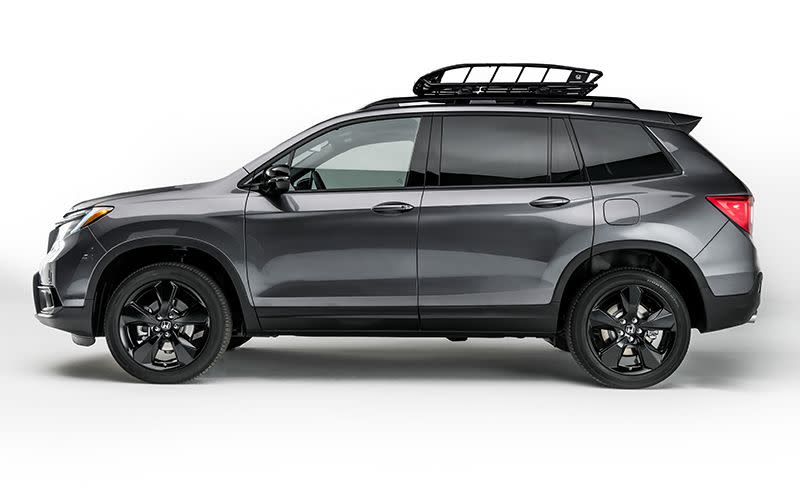The 2019 Honda Passport Is the Two-Row Mid-Size SUV Honda Has Sorely Lacked
UPDATE, 12/5/18: Production of the 2019 Passport began in Lincoln, Alabama, today. It will be available in dealerships in early 2019, Honda says, but pricing is still forthcoming. Don't expect the Passport to cost much less than the $32,445 Pilot LX, if at all, given its higher level of standard equipment.
Honda is getting a new stamp in its-ahem-passport this coming year. Destination? More crossover sales, of course, by way of stamping out an all-new Passport SUV from its factory in Lincoln, Alabama. Resurrecting a name last used on an Isuzu-cum-Honda SUV two decades ago, the Passport is a two-row, mid-size crossover that fills the void in Honda's lineup between the compact CR-V and the three-row Pilot.
The Passport is way more Pilot than CR-V, although it resembles a second-generation Subaru Forester wearing a Pilot mask. That perky, familiar stature is no accident. Taking direct aim at popular two-row utes such as the Ford Edge, the Nissan Murano, and the Jeep Grand Cherokee, the Passport eschews those first two competitors' road-focused, stylish personas, instead aping the Jeep's adventurous, off-road-capable image. The Passport's styling is a collection of blocky shapes, black plastic cladding, and (slightly) meatier tires than you'll find on the doughy, bulbous-looking Pilot.
Snappier duds aside, the Passport is little more than a truncated Pilot. The two SUVs share a 111.0-inch wheelbase, and Honda simply lopped 6.5 inches from the Pilot's length (mostly from the rear overhang) and removed the third-row seat. Those changes, along with unique rear styling, are what most separate the Passport from the Pilot.
Honda would have you believe that off-road capability is another differentiating factor. We're more skeptical of that. Sure, the Passport has slightly more ground clearance than the Pilot-7.8 inches for the front-wheel-drive model, versus 7.3 inches for the Pilot-along with more favorable approach and departure angles (measures of the steepness of obstacles it can crawl up to or away from without scraping its body) and standard 20-inch wheels. But the Passport is merely a car-based crossover, unlike the original, rugged body-on-frame Passport. All-wheel drive isn't even standard fare, and the Passport's optional system is the same used by the Pilot and the mechanically similar Ridgeline pickup truck. Dubbed i-VTM4 (Intelligent Variable Torque Management), this AWD system features Normal, Sand, Snow, and Mud drive settings and is capable of directing torque using the brakes without the added cost, weight, or complexity of a torque-vectoring differential. There is no available two-speed transfer case, as there is on the Jeep Grand Cherokee, and the tires are street-biased all-seasons, not all-terrain grabbers. We'll withhold final judgment until we sample the Passport off-road for ourselves, but frankly, the idea that any 2019 Passport will be caught chasing Grand Cherokees down goat trails is the stuff of the Honda marketing people's fevered dreams.
This vehicle is a two-row Pilot by another name. Both share a 280-hp 3.5-liter V-6, though the Passport only gets the upper-level Pilot's nine-speed automatic transmission. On a practical level, the Pilot association is great news. The Passport holds nearly as much stuff as does its bigger brother, giving up only six cubic feet of cargo room to the Pilot behind its second-row seats and six cubes behind its first-row seats. Its 41 cubic feet of cargo space (78 with the second-row seats folded) crushes the Jeep Grand Cherokee's 36- and 68-cubic-foot capacities, as well as the Ford Edge's 39 and 73.
Sit in the Passport's front seats, and you would swear you're in a Pilot. The dashboard, steering wheel, and center console are all exactly the same as the Pilot's. Honda's Touchscreen Infotainment System Penance Tour of 2018 continues, as the company really, really wants you to know that the Passport's optional 8.0-inch touchscreen with Apple CarPlay and Android Auto is supported by a physical volume knob, not the infuriatingly fussy capacitive slider that Honda mercifully sent to a farm upstate. Base Passport Sport models use a smaller, non-touch radio that adds a physical tuning knob into the mix, just like the entry-level Ridgeline.
Beyond the Sport trim, Honda will offer the Passport in EX-L, Touring, and Elite trims. The first three come standard with front-wheel drive, while the top-level Elite gets AWD standard. Other differences include tire size: The Sport and EX-L ride on 245/55R-20 tires while the Touring and Elite use 265/45R-20 rubber. Every Passport gets the Honda Sensing suite of active-safety features, a bundle that includes adaptive cruise control, automated emergency braking, forward-collision warning, and lane-departure warning with lane-keeping steering assist. Full-LED exterior lighting also is standard, along with push-button starting, keyless entry, three-zone climate control, and a 215-watt audio system with six speakers and a subwoofer.
Stepping up to higher trim levels brings a more bumpin' sound system, extra safety gear such as blind-spot monitoring and parking sensors, an onboard data connection with Wi-Fi hotspot, leather seats, a power tailgate, inductive phone charging, a sunroof, and more. Buyers can look forward to a bevy of accessories to choose from, including Adventure and Urban themed packages. (The Adventure gear, including a roof rack and basket, side steps, and black wheels, is pictured in the gallery.) Pricing is forthcoming, but don't expect the Passport to cost much less than the $32,445 Pilot LX, if at all, given its higher level of standard equipment.
('You Might Also Like',)

 Yahoo Autos
Yahoo Autos 

